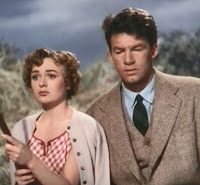 |
| Doris Day and James Stewart as the McKennas. |
Later, at the police station, Ben receives a phone call that his son has been kidnapped and will remain safe as long as he says nothing to the authorities. When they return to their hotel, Ben and Jo realize that the Draytons kidnapped Hank. They follow them to London, determined to find their son.
 |
| Brenda De Banzie as Mrs. Drayton. |
There are still sequences featuring Hitchcock at his best, such as when the face of the disguised Bernard slides through Ben's hands, leaving brown make-up on his fingers. The Albert Hall scene, in which an assassin's shot must be timed with the crash of cymbals, shows Hitchcock at the height of his craft. It also features composer and frequent Hitch collaborator Bernard Herrmann as the orchestra's conductor.
James Stewart and Doris Day are fine as the determined parents and Doris even gets to sing the Oscar-winning "Que Sera, Sera," which would become her signature song. Acting honors, though, go to the marvelous Brenda De Banzie as a reluctant kidnapper.
 |
| Doris walking in the fog. |
Kit's problem is that no one else hears the disturbing phone calls. Is she delusional and imagining the voice? Or is someone really planning to kill her? There are certainly plenty of suspects: the housekeeper's creepy son (Roddy McDowell); the handsome construction chief (John Gavin) working on a nearby building; the strange man hanging around the neighborhood; or even her husband Tony.
 |
| Doris Day and Rex Harrison. |
Unlike The Man Who Knew Too Much, Midnight Lace is a "Doris Day vehicle" and she's in almost every scene. For the most part, she carries the picture, although her histrionics in the later scenes verge on overacting. Director David Miller compensates by keeping the narrative to a crisp 103 minutes.
Midnight Lace was remade for television in 1981 with Mary Crosby in the lead role. Carolyn Jones has a supporting role in that version, just as she did in The Man Who Knew Too Much!




























